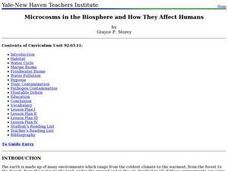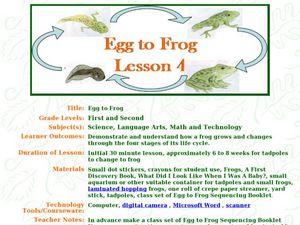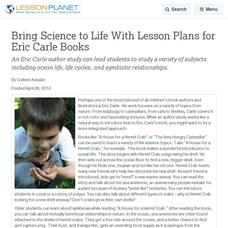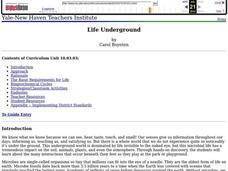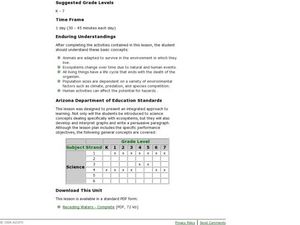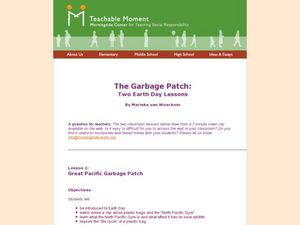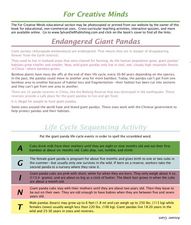Curated OER
Inviting Butterflies to the Schoolyard
Students create a butterfly garden. In this butterfly garden lesson, students plot a garden with plant species that will attract butterflies. Students learn about the specific plants and items that will help butterflies use the garden.
Curated OER
Red Wigglers
Students are introduced to the benefits of using Red Wiggler worms to produce compost. They identify the requirements for the worms and the methods to follow in order to produce compost. They draw a picture of a functioning worm bin.
Curated OER
Animal Life Stages
Guide your young scientists in reviewing basic animal processes including digestion and reproduction. Students review the stages of metamorphosis and the different types of body symmetry. This worksheet has 8 matching, 6 true or false, 4...
Curated OER
Baby Animals
In this baby animal graphic organizer, students write in four examples of young animals that look like their parents, and two examples of young animals that look different from their parents.
Curated OER
Science: Microcosms in the Biosphere
In a series of lessons, examine the impact on humans by microcosms in the biosphere. Among the plans structured for students with different abilities and learning styles, are activities describing the symbiotic relationship, drawing the...
Curated OER
Week 8 - Sea Life
Using a magnifier, mini marine biologists examine the barbules of a bird feather. They swirl the it into a mixture of oil and water and then re-examine the feather. After the activity, discuss how the oily feathers pose a problem to...
Environmental Protection Agency (EPA)
Teachers' Guide to Using A Day In the Life of a Drop
Hydrology hopefuls learn about their local watershed. Through discussion and online interactives, they see that their habits affect the water supply. The lesson concludes with a pledge to filter out bad water usage habits. It makes a...
Curated OER
Hawaii's Sea Turtle Exploration
Students investigate the life cycle and body parts of Hawaii's sea turtles. In this sea turtle lesson, students watch a video about the turtle life cycle and make a model of a "Honu," sea turtle. They complete an associated worksheet.
Alabama Learning Exchange
Stars
Fourth graders examine the life cycle of a star while listening to Roy Gallent's, When the Sun Dies. They conduct Internet research and recreate a star's life cycle after viewing an animation.
Curated OER
What Happens to a Seed?
For this creative lesson on seeds, 1st graders listen as the book The Tiny Seed by Eric Carle is read to them about the life of a seed. Students then draw a picture to show the life cycle of a seed in each season.
Curated OER
Egg to Frog
Students study the life cycle of the frog. For this life cycle lesson set, students listen to a read aloud of Frogs, A First Discovery Book, and make a sequencing booklet that shows the four stages of the frogs life cycle. They observe...
Curated OER
Bring Science to Life With Lesson Plans for Eric Carle Books
An Eric Carle author study can lead students to study a variety of subjects including ocean life, life cycles, and symbiotic relationships.
Curated OER
Life Underground
First graders build a terrarium in order to observe animal and plant life dynamics. In this biology lesson, 1st graders compare how organisms survive in different environments. They write their observations and analysis in their journal.
Curated OER
Receding Waters
Students explore the effect of environmental factors on ecosystems. In this wildlife and ecology lesson, students identify and describe the stages in a frog's life cycle. Students participate in a simulation demonstrating the...
Curated OER
The Garbage Patch: Two Earth day Lessons
Learners view a seven minute video called Gorilla in the Greenhouse. In this Earth day lesson, students review the history of Earth day. Learners work in groups to describe the life cycle of a plastic bag. Students understand that...
Curated OER
Endangered Giant Pandas
In this giant panda activity, students read and complete 5 pages of information and activities pertaining to the giant panda. Students study maps of the area, read fun facts about pandas, cut and paste life cycle sequencing, and read...
Curated OER
The Cell Cycle
In this biology worksheet, students label 9 diagrams with the correct names. They also write short answers to 6 questions that follow.
Curated OER
Wigglers, Tumblers, & Bloodsuckers
Students explore the life stages of a mosquito. In this animal biology lesson, students read Why Mosquitoes Buzz in People's Ears by Verna Aardema and complete several activities including an experiment with mosquito larvae, an activity...
Curated OER
The Water Cycle and Sources of Pollution
Students make an island that has a construction site on it. They spill siulated pollution and trash on top of the island and then water it to simulate rain. They will observe how the rain washes dirt, sand, and pollution off the island...
Curated OER
Butterfly Crossword (On-line Interactive)
In this butterflies worksheet, students complete a 20 word online interactive crossword puzzle about the life cycle of a butterfly. Students read each clue, type their answers into the puzzle and check them.
National Wildlife Federation
Penguin Fun Facts
What's black and white and can dive up to 1,800 feet under water? That's right, penguins! Learn this and many other amazing facts about these unique birds with this handy reference sheet.
Michigan Farm Bureau
The Little Red Hen
No one will be saying "Not I" with a lesson that combines The Little Red Hen with the life cycle of a wheat stem! After reading the story in your class, pass out wheat stems to your learners and have them examine the plants closely,...
Chicago Botanic Garden
Preparing for Project BudBurst
Plants take cues from the environment—change in daylight hours and temperature—to complete their seasonal life cycles. Lesson four in the series of six has classes collect phenology data on plants. After taking initial observations,...
Education Outside
Leaf Adaptations
Long life or a fast life cycle? Class members each gather a leaf, observe its characteristics such as texture, surface, scent, design, shading, and size and then discuss the adaptations made for survival as well as what the leaf reveals...




